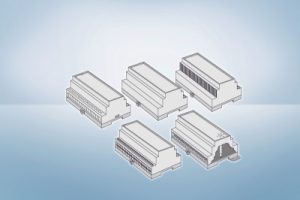Series 1570
DIN Rail Enclosure with Terminals
In the world of electrical and electronic installations, DIN rail enclosure with terminals offers a comprehensive solution for housing and connecting various components within control panels and industrial settings. This article explores the significance, features, and applications of DIN rail enclosures with terminals.
What is a DIN Rail Enclosure with Terminals?
A DIN rail enclosure with terminals is a specialized housing unit designed to accommodate electrical and electronic components in a secure and organized manner. These enclosures are typically made of robust materials such as metal or plastic, ensuring durability and protection against environmental factors like dust, moisture, and impact.
One of the distinguishing features of these enclosures is the presence of terminals or terminal blocks inside. Terminals are connection points where wires or cables can be securely attached, facilitating easy and efficient wiring. DIN rail enclosures often feature standardized mounting rails, such as DIN rails, which allow for quick and convenient installation in control panels and cabinets.
Key Features of DIN Rail Enclosures with Terminals
- Modular Design: DIN rail enclosures are available in various sizes and configurations, making them highly adaptable to different applications. Their modular design allows for the integration of components like terminal blocks, circuit breakers, relays, and more.
- Terminal Blocks: Terminal blocks are a crucial component of these enclosures. They provide a convenient and organized way to connect wires and cables, reducing the risk of loose connections and electrical hazards.
- Protection: DIN rail enclosures are designed to offer protection against environmental elements, including dust, water, and mechanical damage. Many models are rated according to IP (Ingress Protection) standards to indicate their level of protection.
- Versatility: These enclosures find applications in a wide range of industries, including manufacturing, automation, energy, and telecommunications. They can house components for motor control, lighting systems, power distribution, and more.
- Easy Installation: The standardized DIN rail mounting system simplifies installation within control panels and cabinets. Components can be securely snapped onto the DIN rail, saving time and effort during assembly.
- Labeling and Marking: Many DIN rail enclosures come with labeling options, allowing for clear identification of terminal connections and components. This aids in troubleshooting and maintenance.
Applications of DIN Rail Enclosures with Terminals
- Industrial Control Panels: DIN rail enclosures are commonly used to house components like relays, timers, and controllers in industrial control panels. Their modular design makes it easy to customize panels for specific applications.
- Power Distribution: In electrical distribution systems, DIN rail enclosures are employed to house circuit breakers, fuse holders, and power distribution blocks. This ensures safe and organized power distribution.
- Automation and PLCs: Programmable Logic Controllers (PLCs) and automation components often require protection from harsh environments. DIN rail enclosures provide the necessary shelter while allowing easy access for maintenance and troubleshooting.
- Renewable Energy: Solar inverters, wind turbine controllers, and other renewable energy components benefit from DIN rail enclosures. These enclosures safeguard critical electronics in outdoor installations.
- Building Automation: In building management systems, DIN rail enclosures house components for lighting control, HVAC systems, and security systems. Their compact size is ideal for space-constrained environments.
Conclusion
DIN rail enclosures with terminals play a pivotal role in ensuring the integrity and efficiency of electrical and electronic installations. Their modular design, protection features, and versatility make them indispensable in various industries. Whether it’s controlling industrial processes, distributing electrical power, or managing building automation systems, these enclosures provide a reliable and organized solution for housing essential components. With their standardized mounting options and labeling capabilities, DIN rail enclosures contribute to the seamless operation and maintenance of critical systems.





